Cochiti Pueblo Santa Claus Figurine with Two Boys by Louis and Virginia Naranjo - C3088B
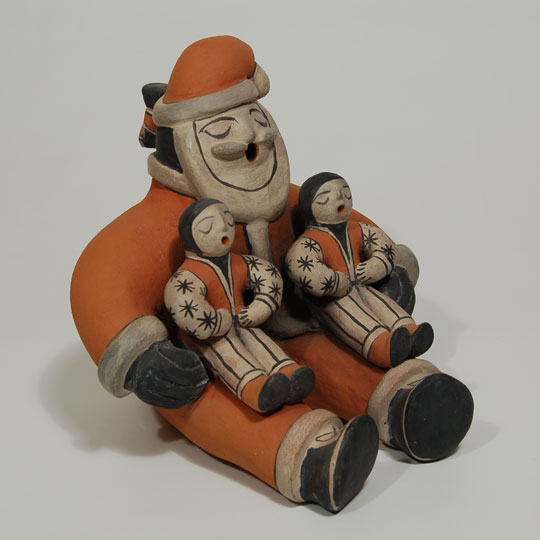 Louis Naranjo and his wife, Virginia, were true innovators of the figurative pottery tradition of Cochiti Pueblo. They crafted their figurines at the kitchen table in their comfortable adobe home at the pueblo. They worked almost every day crafting their art with great care, joking and exchanging the gossip of the day as they went along, accompanied by television, children and grandchildren. Their art provided a good life for them and it provided a legacy that will be with us for another century or more.
Louis Naranjo and his wife, Virginia, were true innovators of the figurative pottery tradition of Cochiti Pueblo. They crafted their figurines at the kitchen table in their comfortable adobe home at the pueblo. They worked almost every day crafting their art with great care, joking and exchanging the gossip of the day as they went along, accompanied by television, children and grandchildren. Their art provided a good life for them and it provided a legacy that will be with us for another century or more.
Hopi Pueblo Silkafragoingtaqa - Bean Dance Katsina Doll - C3535.30
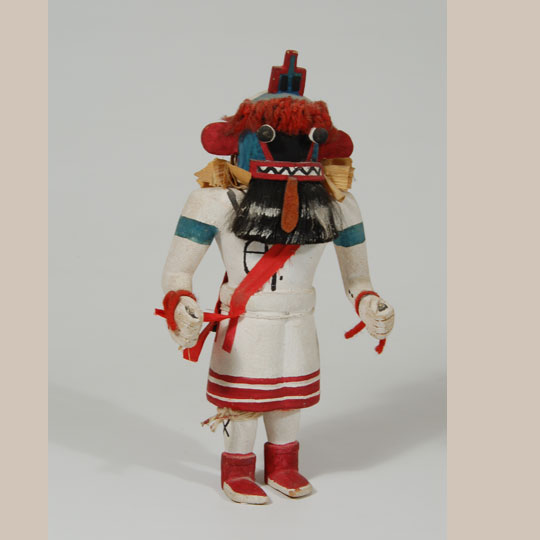 The Bean Dance is properly called the Powamu and it is one of the most important of the Hopi ceremonies. Powamu occurs in February each year in most of the Hopi villages. A most important aspect of this ceremony is the anticipation of the coming growing season, with ritual designed to promote fertility and germination. To accomplish this the Powamu chief appears as Muyingwa, the principal deity of germination, and every male who has been initiated into the katsina cult is expected to grow beans in the kivas. Growing bean sprouts gives the ceremony its popular name, and offers omens for the success of the coming growing season. The procession of the Pachavumanas carrying these bean sprouts and the presentation of ritual bundles of them to the women and children during the heights of the winter are tangible evidence of the presence of Muyingwa. Wright, 1973, p17.
The Bean Dance is properly called the Powamu and it is one of the most important of the Hopi ceremonies. Powamu occurs in February each year in most of the Hopi villages. A most important aspect of this ceremony is the anticipation of the coming growing season, with ritual designed to promote fertility and germination. To accomplish this the Powamu chief appears as Muyingwa, the principal deity of germination, and every male who has been initiated into the katsina cult is expected to grow beans in the kivas. Growing bean sprouts gives the ceremony its popular name, and offers omens for the success of the coming growing season. The procession of the Pachavumanas carrying these bean sprouts and the presentation of ritual bundles of them to the women and children during the heights of the winter are tangible evidence of the presence of Muyingwa. Wright, 1973, p17.
Kewa Pueblo Sterling Silver Belt Buckle by Roderick and Marilyn Tenorio - C3852i
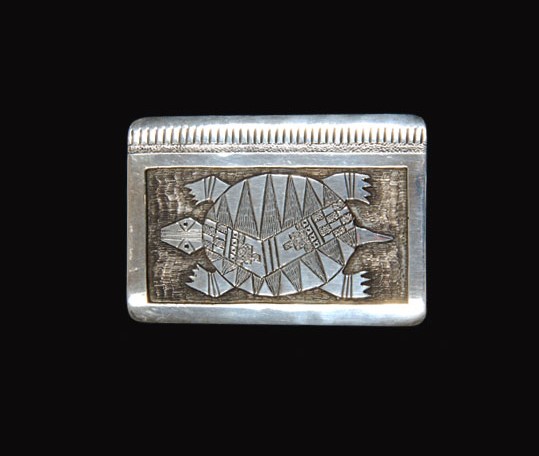 Roderick Tenorio and his wife, Marilyn, often collaborate on making jewelry and each also works separately. This buckle is a collaborative effort. It features a turtle overlaid on a darkened background in a typical overlay technique.
Roderick Tenorio and his wife, Marilyn, often collaborate on making jewelry and each also works separately. This buckle is a collaborative effort. It features a turtle overlaid on a darkened background in a typical overlay technique.
Roderick graduated from Albuquerque High School in 1981, then attended the Institute of American Indian Arts in Santa Fe. He served time in the U. S. Army. He is a top prizewinning artist. Marilyn Tenorio is a Navajo and works in mosaic inlay as well as silver and gold jewelry.
Aquatint Etching “Changing Woman” by Helen Hardin Tsa-Sah-Wee-Eh - 25918
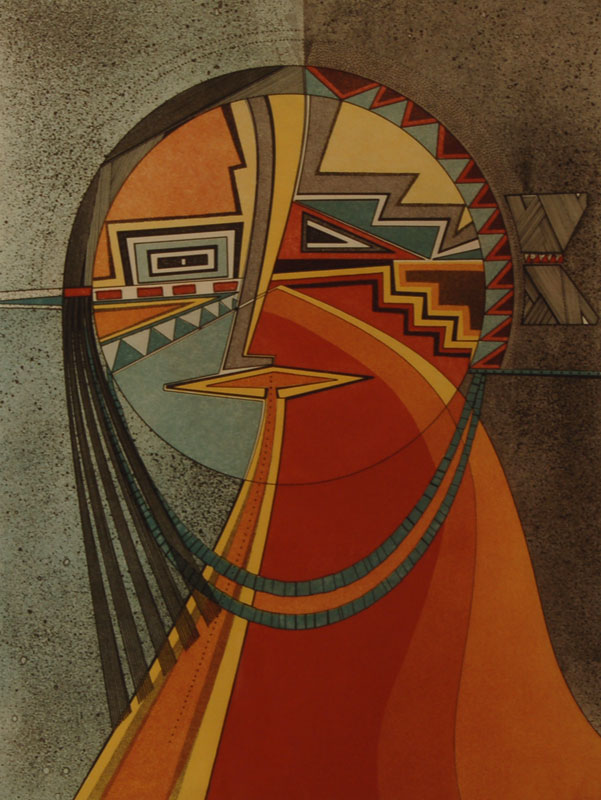 Sue Di Maio, an art dealer from California, Arizona, and Santa Fe, made it her mission to talk Helen Hardin into supplementing her acrylic painting with carefully controlled prints. She felt that Helen could not keep up with the demand for her art if she only produced original paintings. At first, Helen was not in agreement. Helen agreed to meet with Richard Ximinez of El Cerro Graphics in Los Lunas, New Mexico, for a primer in printmaking. Helen agreed to give printmaking a try. Fortunately, she loved it and collectors love her prints too.
Sue Di Maio, an art dealer from California, Arizona, and Santa Fe, made it her mission to talk Helen Hardin into supplementing her acrylic painting with carefully controlled prints. She felt that Helen could not keep up with the demand for her art if she only produced original paintings. At first, Helen was not in agreement. Helen agreed to meet with Richard Ximinez of El Cerro Graphics in Los Lunas, New Mexico, for a primer in printmaking. Helen agreed to give printmaking a try. Fortunately, she loved it and collectors love her prints too.
Aquatint Etching entitled “Medicine Woman” by Helen Hardin Tsa-Sah-Wee-Eh - 25917
Among the most famous and sought after work by Helen Hardin, Santa Clara Pueblo, is a series of three aquatint etchings she named Changing Woman, Listening Womanand Medicine Woman. Changing Woman, executed in 1981, was the first of the three. Hardin said she did not intend to work in a series but "when Changing Womanturned out so well I decided to go ahead." Scott 1989, 135
Exactly a year later, she made Medicine Woman, and the following year, Listening Woman. In this series, Hardin concentrated on attributes of women-self-sufficiency, active anguish, covert ecstasy, acceptance of grief, and the virtue of endurance. She focused on the heads of the women to emphasize the strength of the head because women are emotional and sensitive.
Polished Black Domed Jar with Spider Design by Tahn Moo Whe - 25920
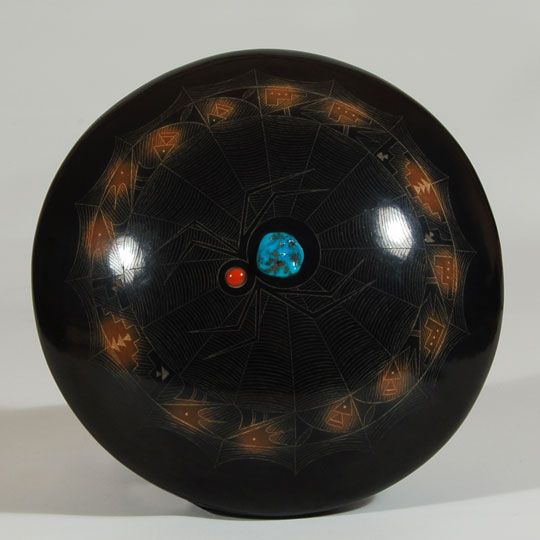 Barbara Gonzales is an excellent potter and an extension of her famous great-grandmother, Maria Martinez, and her grandparents, Adam and Santana Martinez. Her mother, Anita Martinez, was also a potter. Drawing on the traditions of her family, she expanded this tradition by personalizing her pottery with inlaid coral and turquoise on etched black and sienna wares-often inlaid on spider designs which she created in 1973. Early in her career she occasionally made plain black polished pottery, but no longer does so, nor does any other potter from San Ildefonso Pueblo.
Barbara Gonzales is an excellent potter and an extension of her famous great-grandmother, Maria Martinez, and her grandparents, Adam and Santana Martinez. Her mother, Anita Martinez, was also a potter. Drawing on the traditions of her family, she expanded this tradition by personalizing her pottery with inlaid coral and turquoise on etched black and sienna wares-often inlaid on spider designs which she created in 1973. Early in her career she occasionally made plain black polished pottery, but no longer does so, nor does any other potter from San Ildefonso Pueblo.
Original Hopi Pueblo Painting of “Shotoknanguh” signed Seekyesva - C3098D
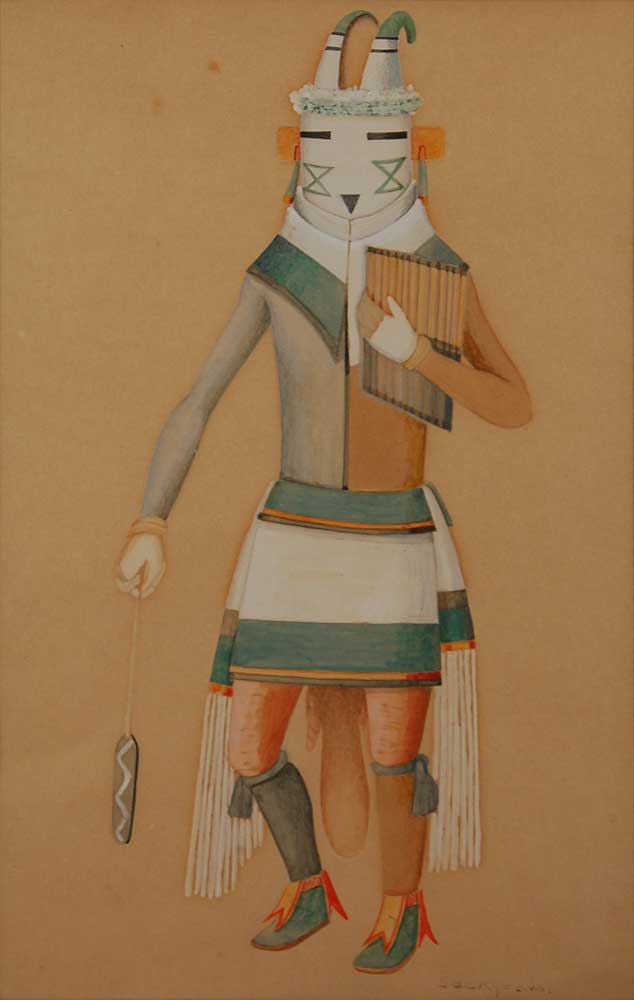 According to Colton in Hopi Kachina Dolls with a Key to their Identification,"Sotuqnang-U is the god of the sky, the clouds, and the rain, and is good, dignified and powerful." Colton lists him as one of 36 Hopi Deities-some of whom are represented as Katsinas and others not. When represented, he wears a white case mask with cloud designs on the cheeks. In his left hand, he carries a lightning frame and in his right hand, a bull roarer. The lightning frame is expandable and used to imitate the appearance of summer lightning. The bull roarer simulates the sound of thunder.
According to Colton in Hopi Kachina Dolls with a Key to their Identification,"Sotuqnang-U is the god of the sky, the clouds, and the rain, and is good, dignified and powerful." Colton lists him as one of 36 Hopi Deities-some of whom are represented as Katsinas and others not. When represented, he wears a white case mask with cloud designs on the cheeks. In his left hand, he carries a lightning frame and in his right hand, a bull roarer. The lightning frame is expandable and used to imitate the appearance of summer lightning. The bull roarer simulates the sound of thunder.
Santa Clara Pueblo Black Carved Bowl with Avanyu Design by Teresita Naranjo - C3681B
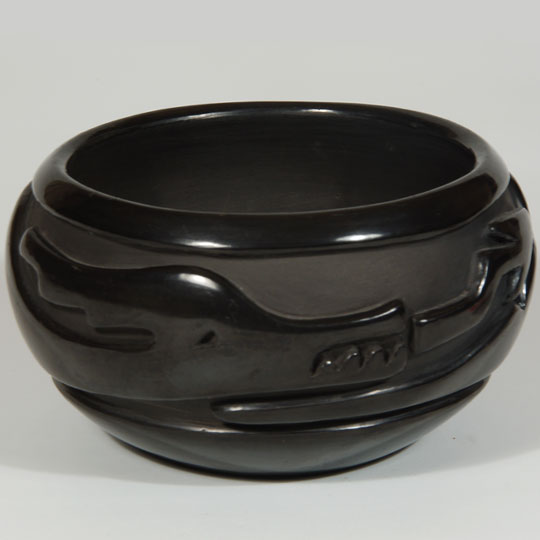 Teresita Tafoya Naranjo (1919-1999) Apple Blossom - Bay-Po-Vi was the daughter of Christina Naranjo and granddaughter of Sara Fina Tafoya. She has been acknowledged as one of the finest 20th century potters at Santa Clara Pueblo. Her unexpected death in 1999 was a loss to all pottery collectors. She was active from 1935 to 1999 and was known for her black and redware carved works in the Santa Clara style. After her husband passed away in 1950, she supported her family solely through sales of her pottery.
Teresita Tafoya Naranjo (1919-1999) Apple Blossom - Bay-Po-Vi was the daughter of Christina Naranjo and granddaughter of Sara Fina Tafoya. She has been acknowledged as one of the finest 20th century potters at Santa Clara Pueblo. Her unexpected death in 1999 was a loss to all pottery collectors. She was active from 1935 to 1999 and was known for her black and redware carved works in the Santa Clara style. After her husband passed away in 1950, she supported her family solely through sales of her pottery.
Navajo Sterling Silver Double Pen Holder Desk Accessory - C3856G
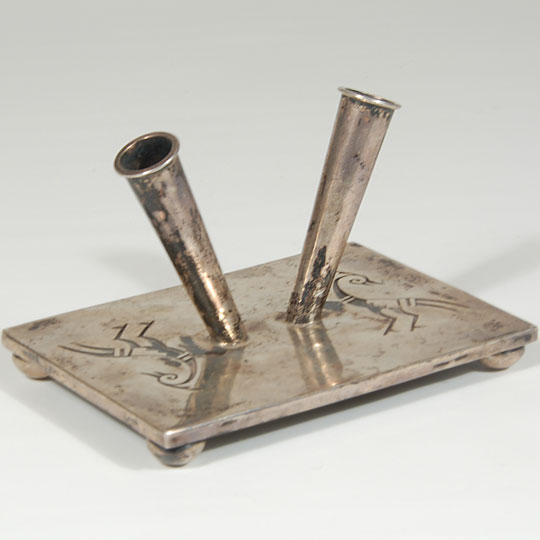 Navajos learned the art of silversmithing from the Mexicans in the mid-19th Century. Atsidi Sani "Old Smith" (1828-1918) is considered to be one of the first Navajo smiths to work with silver. Initially, silver was hammered into the desired shape and designs were chiseled into the piece. Later pieces featured stamp work and turquoise stones. As the demand for tourist pieces increased, more artists could make a living as jewelers. In addition to jewelry, silver objects such as boxes, bookmarks and letter openers were made.
Navajos learned the art of silversmithing from the Mexicans in the mid-19th Century. Atsidi Sani "Old Smith" (1828-1918) is considered to be one of the first Navajo smiths to work with silver. Initially, silver was hammered into the desired shape and designs were chiseled into the piece. Later pieces featured stamp work and turquoise stones. As the demand for tourist pieces increased, more artists could make a living as jewelers. In addition to jewelry, silver objects such as boxes, bookmarks and letter openers were made.
Very Large Magnificent Black Carved Santa Clara Jar by Margaret Tafoya - C3853A
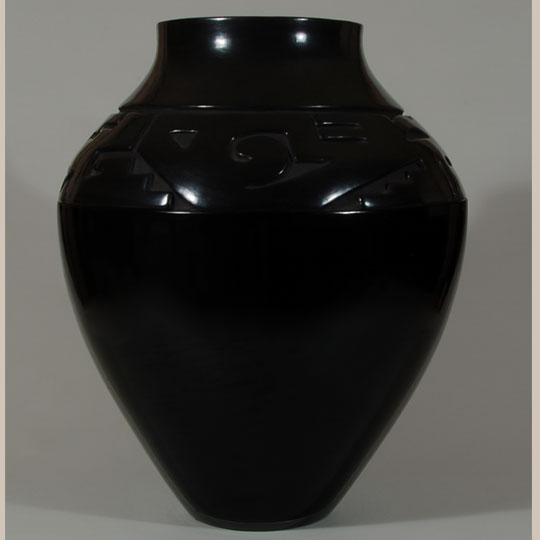 Occasionally a black polished jar just takes one's breath away. That was the effect this jar had on staff at the gallery and has had on clients who walk in to the gallery and see it. We all know that Margaret Tafoya was an amazing potter who produced large and magnificent wares, but, even so, it is still an emotional shock to see a jar that is so commanding of one's attention because it is so visually magnificent and so elegant and regal. Those may be adjectives not normally ascribed to pottery but they are appropriate for this jar.
Occasionally a black polished jar just takes one's breath away. That was the effect this jar had on staff at the gallery and has had on clients who walk in to the gallery and see it. We all know that Margaret Tafoya was an amazing potter who produced large and magnificent wares, but, even so, it is still an emotional shock to see a jar that is so commanding of one's attention because it is so visually magnificent and so elegant and regal. Those may be adjectives not normally ascribed to pottery but they are appropriate for this jar.
Small Polychrome Pottery Mudhead Figurine by Margaret Gutierrez - C3855D
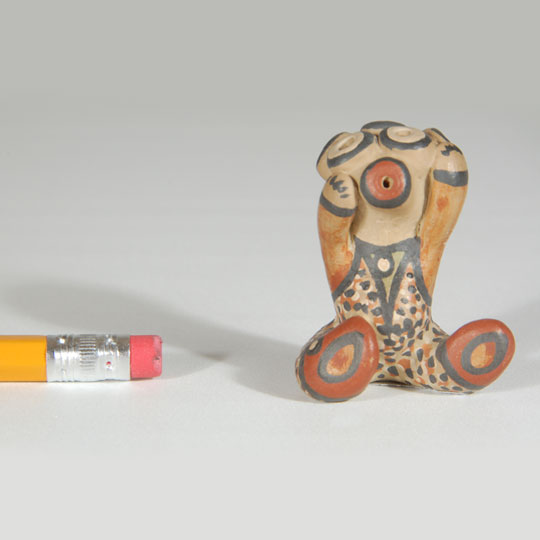 Margaret Gutierrez was the daughter of potters Lela and Van Gutierrez. Lela and Van developed one of the most distinctive and recognizable styles of pueblo pottery. Their use of multicolored pigments to decorate pottery is unique. Margaret and her brother Luther continued painting in this style, and began to create animals and small whimsical figurines. After Luther passed away, Margaret carried on the tradition on her own.
Margaret Gutierrez was the daughter of potters Lela and Van Gutierrez. Lela and Van developed one of the most distinctive and recognizable styles of pueblo pottery. Their use of multicolored pigments to decorate pottery is unique. Margaret and her brother Luther continued painting in this style, and began to create animals and small whimsical figurines. After Luther passed away, Margaret carried on the tradition on her own.
Santa Clara Pueblo Aquatint Etching “Acoma Rooster” by Helen Hardin - 25919
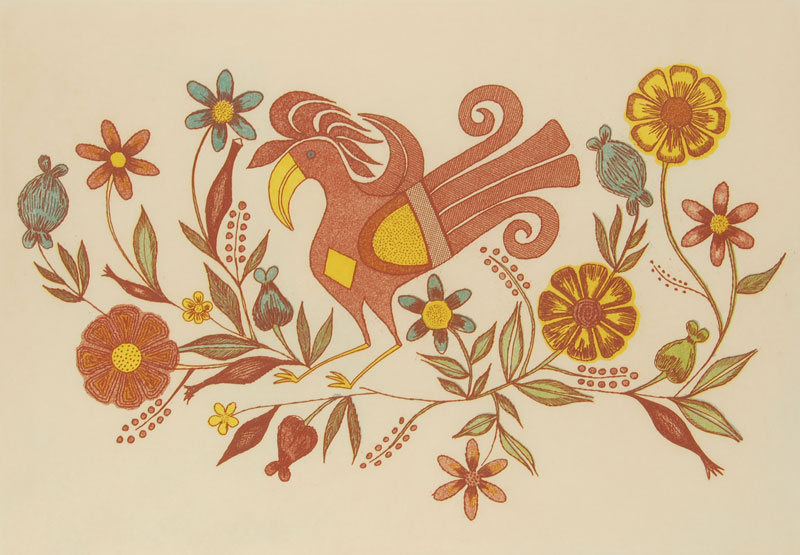 The etching was begun on June 1, 1981 and completed on July 15, 1981. The master printer was Ricardo C. Ximinez at El Cerro Graphics in Los Lunas, New Mexico. The shop mark is on lower left, the printer's mark is on lower right and the artist name, Helen Hardin (1943-1984) Tsa-Sah-Wee-Eh - Little Standing Spruce, is signed in lower right with her hallmark tree image. There were 65 Arabic numbered in the edition and 8 in the Roman numbered edition. This is number III of VIII in the Roman edition, which are the 8 copies allocated to the print shop for its records and distribution. Helen Hardin was from Santa Clara Pueblo.
The etching was begun on June 1, 1981 and completed on July 15, 1981. The master printer was Ricardo C. Ximinez at El Cerro Graphics in Los Lunas, New Mexico. The shop mark is on lower left, the printer's mark is on lower right and the artist name, Helen Hardin (1943-1984) Tsa-Sah-Wee-Eh - Little Standing Spruce, is signed in lower right with her hallmark tree image. There were 65 Arabic numbered in the edition and 8 in the Roman numbered edition. This is number III of VIII in the Roman edition, which are the 8 copies allocated to the print shop for its records and distribution. Helen Hardin was from Santa Clara Pueblo.
Canyon Road ArtCrawl Is Tonight Starting at 4PM
December is a truly wonderful time to come to Canyon Road. The historic adobes and sculpture gardens are beautifully lit for the holidays, the air is crisp and fresh, and there are dozens of places that invite exploration.
It is also the perfect place to find one-of-a kind gifts, ranging from artwork and designer jewelry to hand-crafted furniture and wearable art, stationery and ceramics. Most of the iconic road's 100 fine art galleries, specialty shops, and restaurants will be open 7 days a week during December.
On Friday, December 9th, between 4 and 7pm, you are invited to experience the fusion of the visual and cinematic arts at the Canyon Road ArtCrawl, which takes place at 40 venues on historic Canyon Road.
The Art Crawl is a feature event of the Santa Fe Film Festival and includes a red carpet, a mariachi march down Canyon Road, and art openings at many of the road's 100 galleries and artist studios. The event is organized for the filmmakers, actors, and visitors from around the globe who come to Santa Fe for the festival. The public is welcome. More information
Ink Drawing of Two Warriors on Horseback by Edward Borein - C3827J
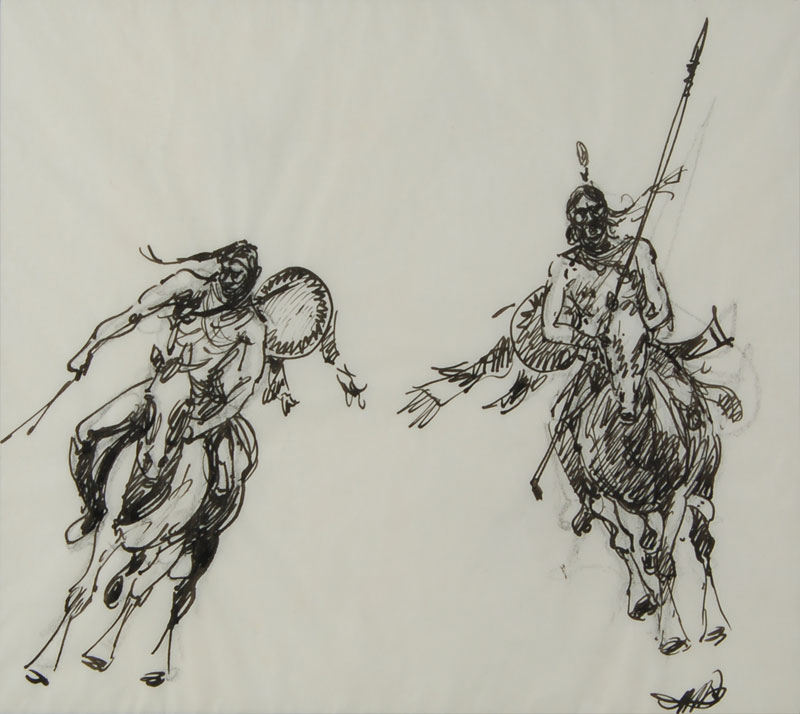 Edward Borein was born at San Leandro, California, not far from San Francisco, in 1873. He began to work as a cowboy at the age of seventeen, and sold his first drawing when he was twenty-one. From that time, onward, irrespective of location as he travelled all over the Southwestern United States and as far south as Guatemala, he was an artist. He remained ever devoted to the practice of his professional skill, and at the same time kept up his interest in cowboy life, to the very end.
Edward Borein was born at San Leandro, California, not far from San Francisco, in 1873. He began to work as a cowboy at the age of seventeen, and sold his first drawing when he was twenty-one. From that time, onward, irrespective of location as he travelled all over the Southwestern United States and as far south as Guatemala, he was an artist. He remained ever devoted to the practice of his professional skill, and at the same time kept up his interest in cowboy life, to the very end.
Navajo Sterling Silver Squash Blossom Necklace - C3856E
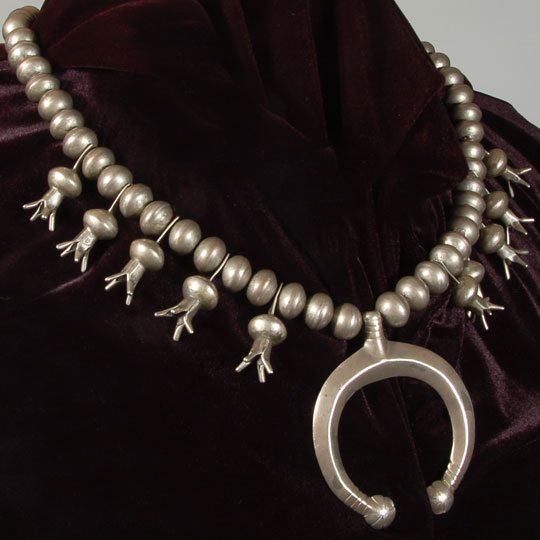 There are 54 silver beads, 10 silver squash blossoms and a naja, all of which are silver. It is strung on rawhide. Early Navajo jewelry contained elements borrowed directly from Spanish colonial and Mexican ornament. The naja is one of these elements, a crescent form of Moorish origin. The Spanish conquerors in the Southwest outfitted their horses with elaborate silver ornaments-one of which was the naja that hung directly on the forehead of the horse as a part of the bridle. The Navajo incorporated the naja in their jewelry as a pendant dangling on silver necklaces, commonly called "squash blossom necklaces." The blossoms are modeled from the pomegranate but have been known as squash blossoms for over a hundred years, so that is not likely to change.
There are 54 silver beads, 10 silver squash blossoms and a naja, all of which are silver. It is strung on rawhide. Early Navajo jewelry contained elements borrowed directly from Spanish colonial and Mexican ornament. The naja is one of these elements, a crescent form of Moorish origin. The Spanish conquerors in the Southwest outfitted their horses with elaborate silver ornaments-one of which was the naja that hung directly on the forehead of the horse as a part of the bridle. The Navajo incorporated the naja in their jewelry as a pendant dangling on silver necklaces, commonly called "squash blossom necklaces." The blossoms are modeled from the pomegranate but have been known as squash blossoms for over a hundred years, so that is not likely to change.
Hopi Cylindrical Jar with Butterfly or Moth Designs by Grace Chapella - C3856B
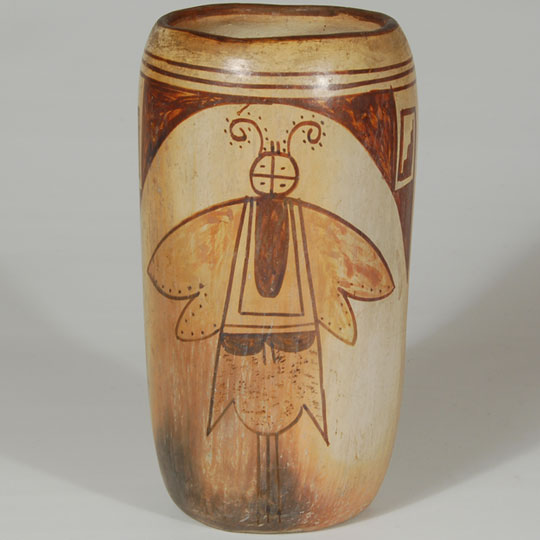 Grace Chapella was born in the Tewa village of Hano at First Mesa on the Hopi Reservation in 1874, eight years before the Reservation was established as such, and before Custer's Last Stand at the Battle of the Little Big Horn. She witnessed the first "horseless carriage" arrive on the Reservation and recalled how frightening it was. In 1927, she became the first person from the Hopi Reservation to fly in an airplane, going from Grand Canyon to Long Beach for a pottery demonstration.
Grace Chapella was born in the Tewa village of Hano at First Mesa on the Hopi Reservation in 1874, eight years before the Reservation was established as such, and before Custer's Last Stand at the Battle of the Little Big Horn. She witnessed the first "horseless carriage" arrive on the Reservation and recalled how frightening it was. In 1927, she became the first person from the Hopi Reservation to fly in an airplane, going from Grand Canyon to Long Beach for a pottery demonstration.
Pictographs in Canyon de Chelly #3 Navajo Painting by Robert Draper - C3827B
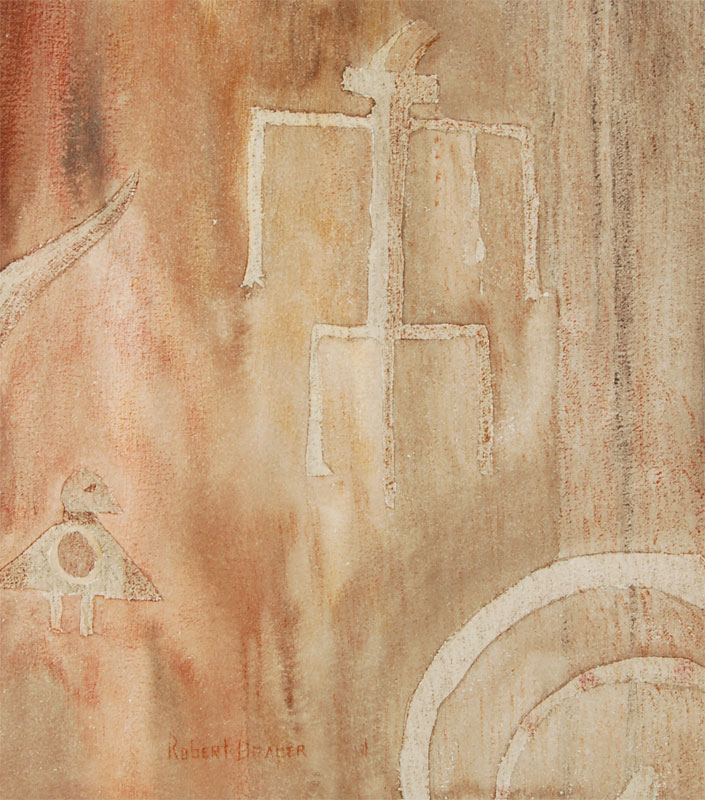 Navajo artist Robert Draper was the child of a Navajo mother and a Hopi-Laguna father. Raised by his grandparents on the Navajo Reservation, he attended-and eventually became an instructor at- the Chinle Boarding School. He was also educated at the Inter-Mountain Indian School in Utah and the Institute of America Indian Arts in Santa Fe. Draper mostly painted realistic landscapes, focusing on everyday life on the Navajo Reservation.
Navajo artist Robert Draper was the child of a Navajo mother and a Hopi-Laguna father. Raised by his grandparents on the Navajo Reservation, he attended-and eventually became an instructor at- the Chinle Boarding School. He was also educated at the Inter-Mountain Indian School in Utah and the Institute of America Indian Arts in Santa Fe. Draper mostly painted realistic landscapes, focusing on everyday life on the Navajo Reservation.
Thinking of hiring an art appraiser?
 Art appraisals are an important part of assessing value for an artwork. This is needed for selling art, donating art, and for some tax and financial purposes. Due to the shifting nature of the market, it’s best to appraise art every 2-5 years. There are several factors to consider when hiring an art appraiser. An improper or biased evaluation could misrepresent the overall value of the piece and could negatively affect future resell. By taking the time to find the proper appraiser, collectors can better maintain their investments.
Art appraisals are an important part of assessing value for an artwork. This is needed for selling art, donating art, and for some tax and financial purposes. Due to the shifting nature of the market, it’s best to appraise art every 2-5 years. There are several factors to consider when hiring an art appraiser. An improper or biased evaluation could misrepresent the overall value of the piece and could negatively affect future resell. By taking the time to find the proper appraiser, collectors can better maintain their investments.
Traditional Hopi Pueblo Chusona or Snake Dance Doll - C3843D
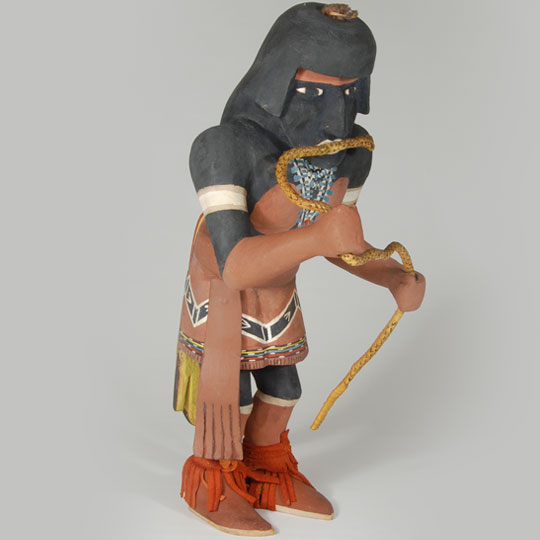 At the end of the nineteenth century, very few tourists had ever seen the Hopi Snake Dance; however, many had heard tales of a dramatic ritual that only occurred every other year in isolated Indian villages in Arizona. This religious ceremony that Victorian society found so horrifying-and so fascinating-soon grew into a symbolic representation of "Indian Country" in the Southwest. The Passenger Department of the Santa Fe Railway played upon sensationalist, tourist visions of American Indians when it published Walter Hough's travel guide The Moki Snake Dance. It was described as A popular account of that unparalleled dramatic pagan ceremony of the Pueblo Indians of Tusayan, Arizona, with incidental mention of their life and customs.
At the end of the nineteenth century, very few tourists had ever seen the Hopi Snake Dance; however, many had heard tales of a dramatic ritual that only occurred every other year in isolated Indian villages in Arizona. This religious ceremony that Victorian society found so horrifying-and so fascinating-soon grew into a symbolic representation of "Indian Country" in the Southwest. The Passenger Department of the Santa Fe Railway played upon sensationalist, tourist visions of American Indians when it published Walter Hough's travel guide The Moki Snake Dance. It was described as A popular account of that unparalleled dramatic pagan ceremony of the Pueblo Indians of Tusayan, Arizona, with incidental mention of their life and customs.
Very Large Seed Jar with Corn Relief Design by Iris Youvella Nampeyo - C3853D
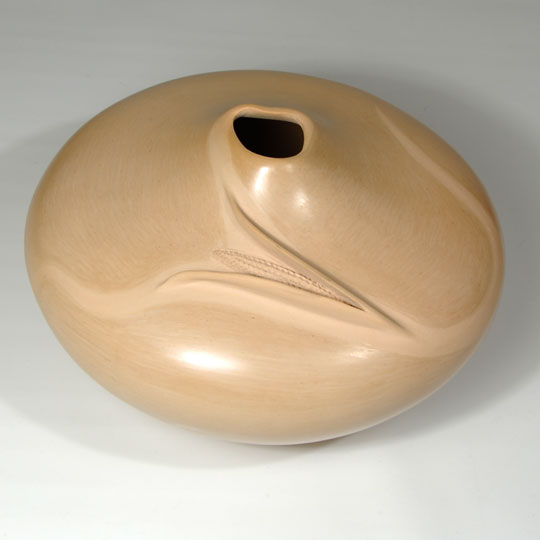 Iris Youvella Nampeyo (1944 -) is known for her sculptural design pottery that she has mastered to the finest detail. This style of sculpture was first made by Elizabeth White (Polingaysi) and further refined by her nephew Al Colton (Qöyawayma). Colton has evolved from the simple corn design to carving cliff dwellings on his pottery.
Iris Youvella Nampeyo (1944 -) is known for her sculptural design pottery that she has mastered to the finest detail. This style of sculpture was first made by Elizabeth White (Polingaysi) and further refined by her nephew Al Colton (Qöyawayma). Colton has evolved from the simple corn design to carving cliff dwellings on his pottery.

